1973 CHEVROLET MONTE CARLO service
[x] Cancel search: servicePage 3 of 86
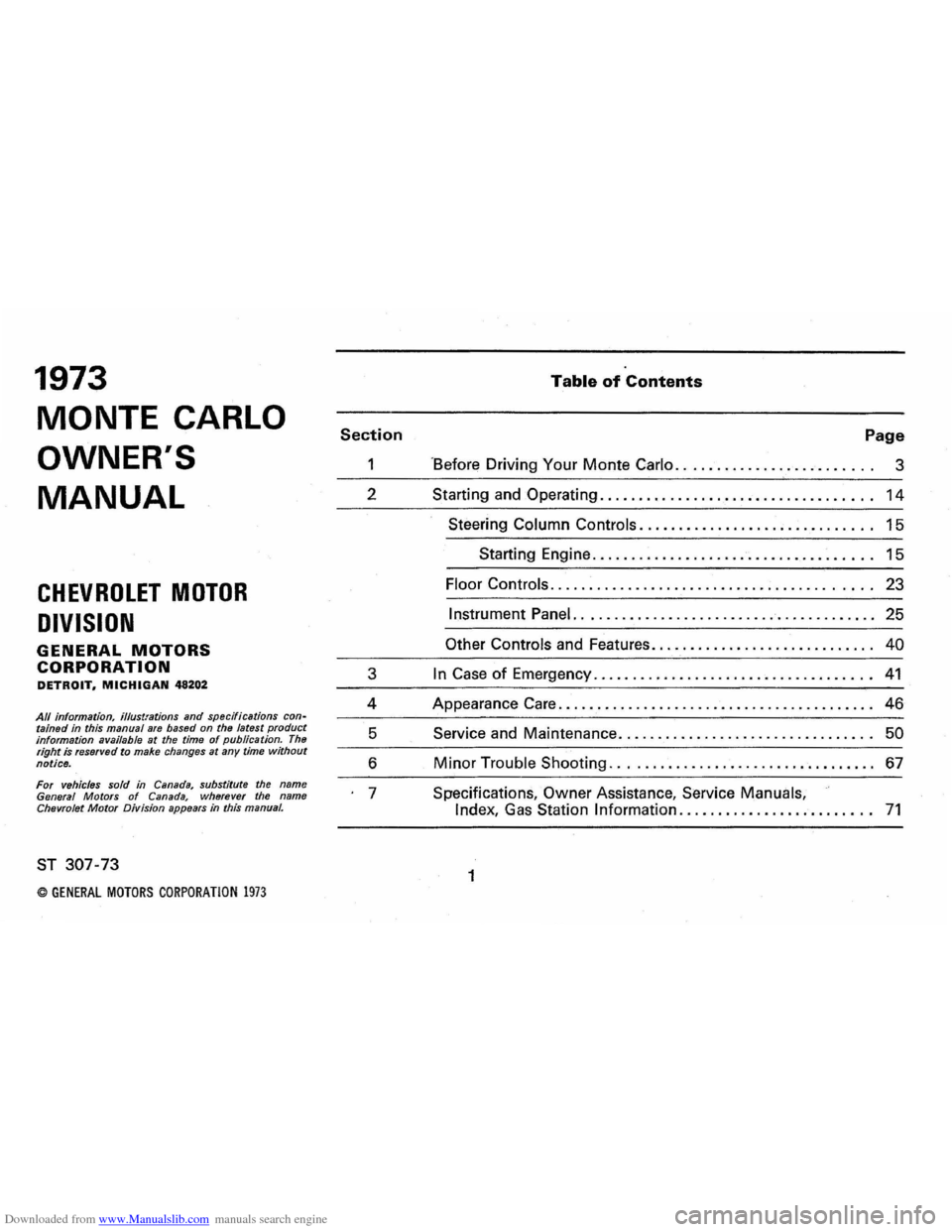
Downloaded from www.Manualslib.com manuals search engine 1973
MONTE CARLO
OWNER'S
MANUAL
CHEVROLET MOTOR
DIVISION
GENERAL MOTORS
CORPORATION DETROIT, MICHIGAN 48202
All information, illustrations and specifications contained in this manual are based on the latest product
information available at the time of publication. The right is reserved to make changes at any time without notice.
For vehicles sold in
Canada, substitute the name
General Motors of Canada, wherever the name
Chevrolet Motor Division appears in this manual.
ST 307-73
© GENERAL MOTORS CORPORATION 1973
Section
1
2
3
4
5
6
7
Table of Contents
Page
' Before Driving Your Monte Carlo.. .................... . .. 3
Starting and Operating . . . .
.. . . . .. . . . . .. . . ... . . . .. .. . . . . .. 14
Steering Column Controls .................. ; . . . . . . . . . .. 15
Starting Engine .............................. '. . . . .. 15
Floor Controls ............................ ; . . . . . . . . . . .. 23
Instrument Panel. . . . . . . . . . . . . . . . . . . . . . . . . .. . . . . . . . . . . .. 25
Other Controls and Features ............................ , 40
In Case of Emergency .................................... 41
Appearance Care ........................................ , 46
Service and Maintenance ................................ , 50
Minor Trouble Shooting .................................. 67
Specifications, Owner Assistance, Service Manuals,
Index,
Gas Station Information. . . . . . . . . . . . . . . . . . . . . . . .. 71
1
Page 15 of 86
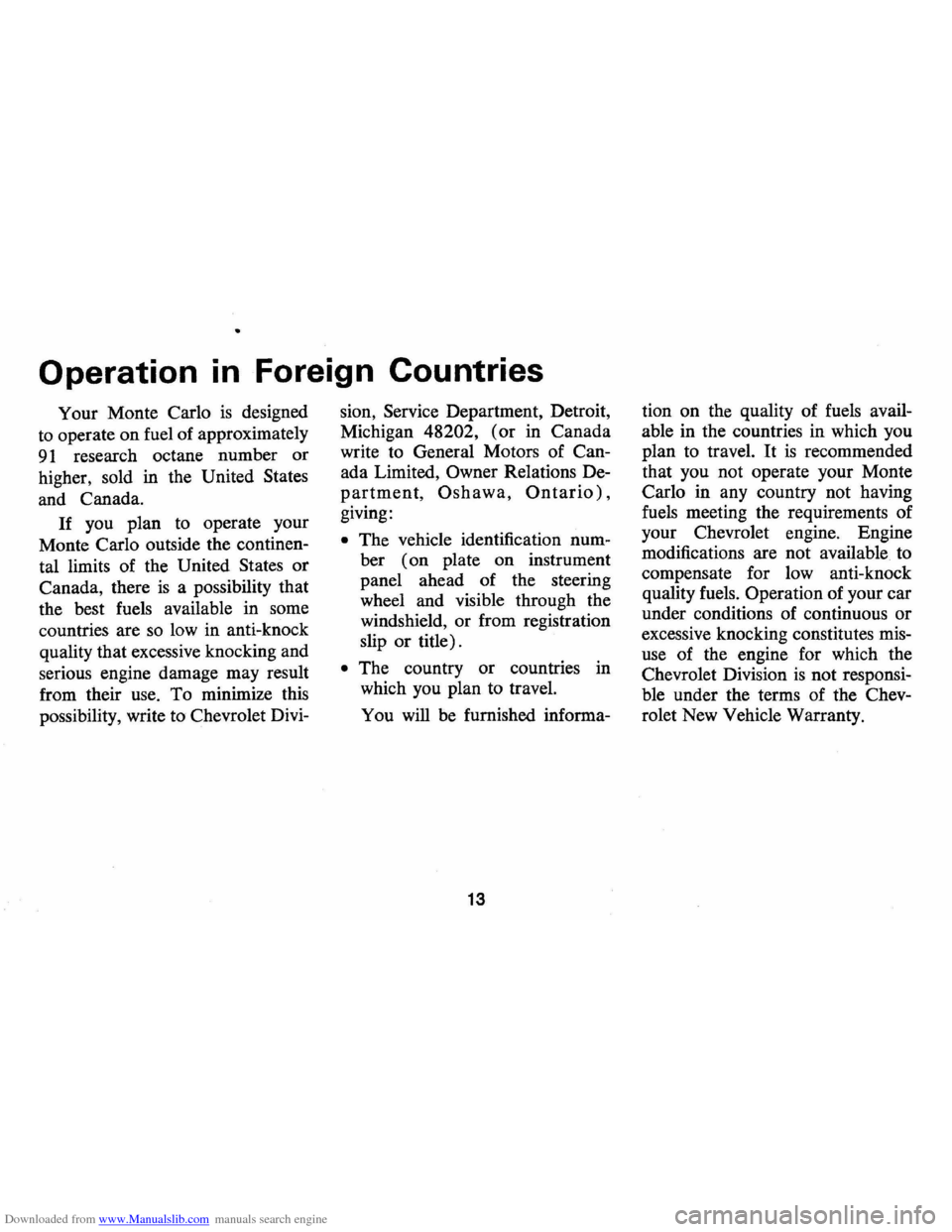
Downloaded from www.Manualslib.com manuals search engine •
Operation in Foreign Countries
Your Monte Carlo is designed
to operate on fuel of approximately
91 research octane number or
higher, sold in the United States
and Canada.
If you plan to operate your
Monte Carlo outside the continen
tal limits of the United States
or
Canada, there is a possibility that
the best fuels available in some
countries are so low in anti-knock
quality that excessive knocking and
serious engine damage may result
from their use. To minimize this
possibility, write to Chevrolet Divi-sion,
Service Department, Detroit,
Michigan 48202,
(or in Canada
write to General Motors of Can
ada Limited,
Owner Relations De
partment, Oshawa, Ontario),
giving:
• The vehicle identification num
ber ( on plate
on instrument
panel ahead of the steering
wheel and visible through the
windshield, or from registration
slip
or title).
• The country or countries in
which you plan to traveL
You will be furnished informa-
13
tion on the quality of fuels avail
able in the countries in which you
plan to traveL
It is recommended
that you not operate your Monte
Carlo in any country not having
fuels meeting the requirements of
your Chevrolet engine. Engine
modifications are not available to
compensate for low anti-knock
quality fuels. Operation of your car
under conditions of continuous
or
excessive knocking constitutes mis
use of the engine for which the
Chevrolet Division
is not responsi
ble under the terms of the Chev
rolet New Vehicle Warranty.
Page 25 of 86
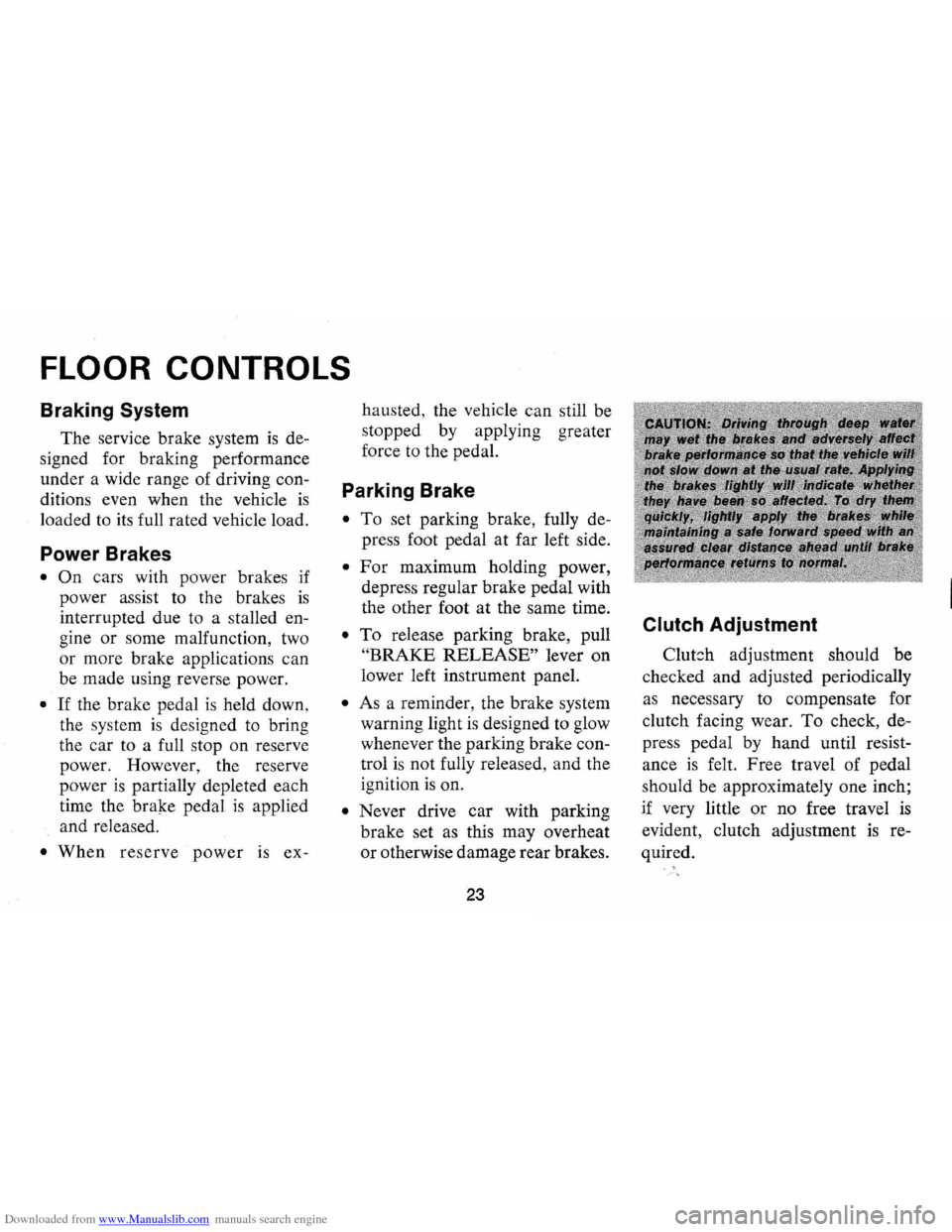
Downloaded from www.Manualslib.com manuals search engine FLOOR CONTROLS
Braking System
The service brake system is de
signed for braking performance
under a wide range of driving con
ditions even when the vehicle
is
loaded to its full rated vehicle load.
Power Brakes
• On cars with power brakes if
power assist to the brakes
is
interrupted due to a stalled en
gine
or some malfunction, two
or more brake applications can
be made using reverse power.
• If the brake pedal is held down ,
the system
is designed to bring
the car to a full stop on reserve
power. However, the reserve
power
is partially depleted each
time the brake pedal
is applied
and released.
• When reserve power is ex- hausted,
the vehicle can still be
stopped by applying greater
force to the pedal.
Parking Brake
• To set parking brake, fully de
press foot pedal at far left side.
• For maximum holding power,
depress regular brake pedal with
the other foot at the same time.
• To release parking brake, pull
"BRAKE RELEASE" lever on
lower left instrument panel.
• As a reminder, the brake system
warning light
is designed to glow
whenever the parking brake con
trol
is not fully released, and the
ignition
is on.
• Never drive car with parking
brake set
as this may overheat
or otherwise damage rear brakes.
23
Clutch Adjustment
Clut8h adjustment should be
checked and adjusted periodically
as necessary to compensate for
clutch facing wear.
To check, de
press pedal by hand until resist
ance
is felt. Free travel of pedal
should be approximately one inch;
if very little
or no free travel is
evident, clutch adjustment is re
quired.
Page 29 of 86

Downloaded from www.Manualslib.com manuals search engine Generator Indicator Light
This light provides a quick
check on the generating system
of your car. The red light will
go on when the ignition key
is
in the "on" position, but before
the engine
is started. After the
engine starts, the light should go
out and remain out.
If the light
remains on when engine
is run
ning , have your Authorized Chev
rolet Dealer locate and correct
the trouble
as soon as possible.
Engine Temperature
Indicator Light
This indicator light is provided
in the
instrument cluster to
quickly warn of an overheated
engine. With the ignition switch
in the
START position, the red
TEMP indicator will light to let
you know that it
is operating
properly. When the engine
is started, the red
light will go out immediately.
It will light up at no other time
unless for some reason the engine
reaches a dangerously high oper
ating temperature.
If the red light
should come on, the engine must
be stopped until the cause of the
overheating
is corrected. Glance
at instrument cluster frequently
as
you drive to see if this light is on.
Brake System Warning Light
The service brake system is
designed so that half of the brake
system will provide some braking
action in the event of a hydraulic
leak in the other half of the
sys
tem. If the warning light located
below the fuel gauge glows con
tinuously when the ignition
is on
and after the brakes have been
firmly applied, it may indicate that
there
is a malfunction in one half
of the brake hydraulic system.
27
• As a check on bulb condition
the light should glow with the
parking brake applied and the
ignition on. (Light
is also a
reminder to release parking
brake) .
• Have system repaired if light
does not come on during check.
• This warning light is not a sub
stitute for the visual check of
brake fluid level required
as
part of normal maintenance.
If the light glows red:
• The parking brake control is not
fully released or,
• The service brake system is
partially inoperative
What to do:
1. Check that the parking brake
is released. If it is ...
2. Pull off the road and stop,
carefully- remembering that:
Page 33 of 86

Downloaded from www.Manualslib.com manuals search engine Clock
Reset the clock , by pulling out
the knob and turning the hands
clockwise
if slow, counterclockwise
if fast. This will, if the clock error
is five minutes or more, automati
cally compensate for time gain or
lag . Several resettings, several days
apart, may be needed to propertly
adjust the clock mechanism. Have
your clock cleaned and oiled by a
competent clock serviceman at
least every two years.
Cigarette Lighter
The cigarette lighter is located
on the instrument panel face.
To
operate, push it in. When it be
comes heated, it automatically pops
out ready for use.
Windshield Wiper and
Washer
The windshield wiping system
operates at two speeds and
is de
signed to wipe clear specific areas of
the windshield under most in
clement weather conditions . The
windshield wipers work electrically
and are not affected by engine op
eration. Push the control lever to the
right to start the electric wind
shield wiper. The two-speed elec
tric wiper has both a "low" and a
"high" speed position.
31
Pressing the control will send a
measured amount of water or other
cleaning agent onto the windshield
and will also cause the wiper lever
to move thus starting the wiper
motor. The wiper will continue to
operate until manually turned off
at the wiper lever.
Fill the washer jar only
% full
during the winter to allow for ex
pansion if the temperature should
fall low enough to freeze the solu
tion .
• Check washer fluid level regu
larly-do it frequently when the
weather is bad .
• Use a fluid such as GM OPTI
KLEEN to prevent freezing
damage, and to provide better
cleaning.
• Do not use radiator anti-freeze
in windshield washer; it could
cause paint damage.
• In cold weather, warm the wind
shield with defrosters before
Page 52 of 86
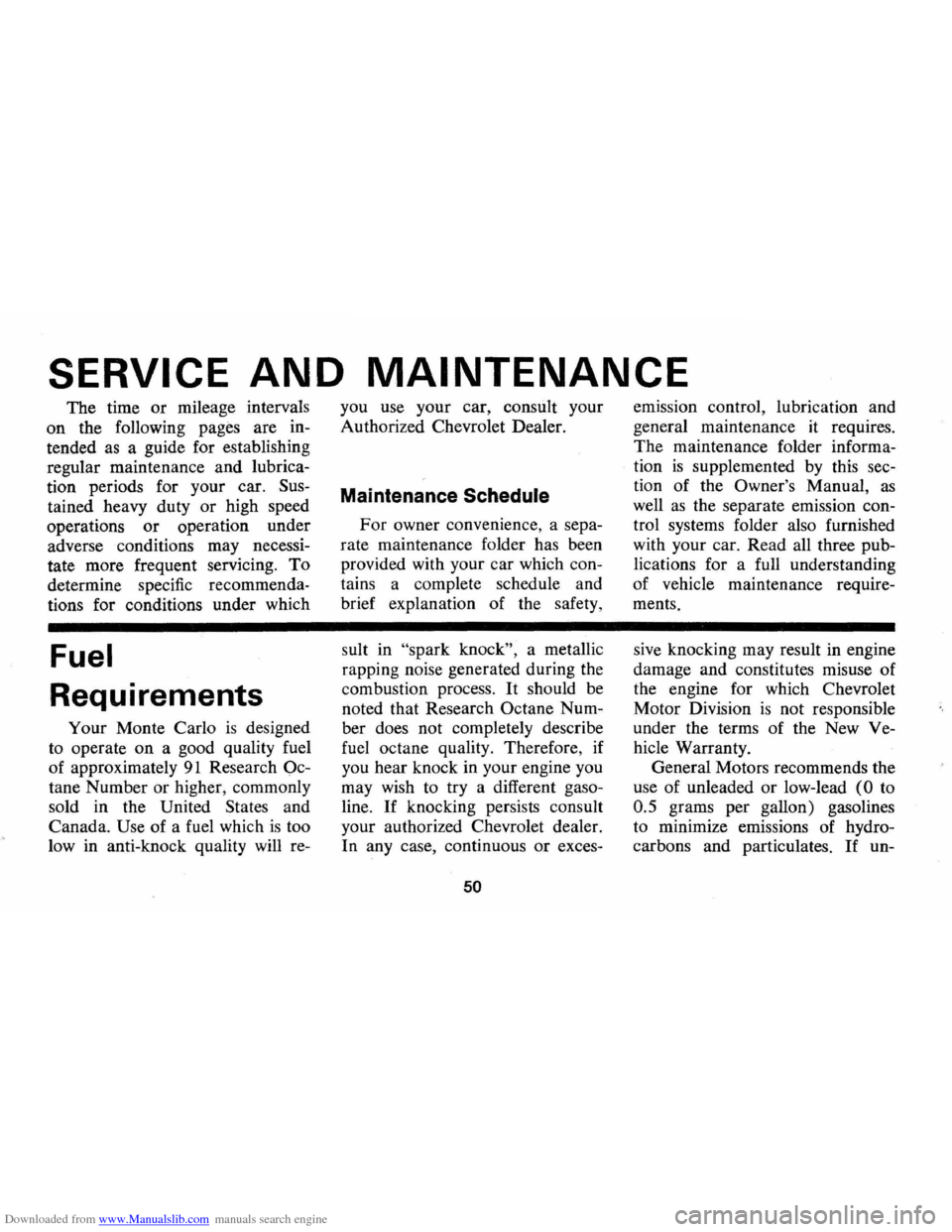
Downloaded from www.Manualslib.com manuals search engine SERVICE AND MAINTENANCE
The time or mileage intervals
on the following
pages are in
tended as a guide for establishing
regular maintenance and lubrica
tion periods for your car. Sus
tained heavy duty or high speed
operations
or operation under
adverse conditions may necessi
tate more frequent servicing.
To
determine specific recommenda
tions for conditions under which
Fuel
Requirements
Your Monte Carlo is designed
to operate
on a good quality fuel
of approximately
91 Research Oc
tane Number or higher , commonly
sold in the United States and
Canada.
Use of a fuel which is too
low in anti-knock quality will re- you
use your car, consult your
Authorized Chevrolet Dealer.
Maintenance Schedule
For owner convenience, a sepa
rate maintenance folder has been
provided with your car which con
tains a complete schedule and
brief explanation of the safety,
suIt in
"spark knock", a metallic
rapping noise generated during the
combustion process. It should be
noted that Research Octane Num
ber does not completely describe
fuel octane quality. Therefore , if
you hear knock in your engine you
may wish to try a different gaso
line.
If knocking persists consult
your authorized Chevrolet dealer.
In any case, continuous
or exces-
50
emission control, lubrication and
general maintenance it requires.
The maintenance folder informa
tion
is supplemented by this sec
tion of the Owner 's Manual,
as
well as the separate emission con
trol systems folder also furnished
with your car. Read all three pub
lications for a full understanding
of vehicle maintenance require
ments.
sive knocking may result in engine
damage and constitutes misuse of
the engine for which Chevrolet
Motor Division
is not responsible
under the terms of the New Ve
hicle Warranty.
General Motors recommends the
use of unleaded or low-lead
(0 to
0.5 grams per gallon) gasolines
to minimize emissions of hydro
carbons and particulates.
If un-
Page 56 of 86
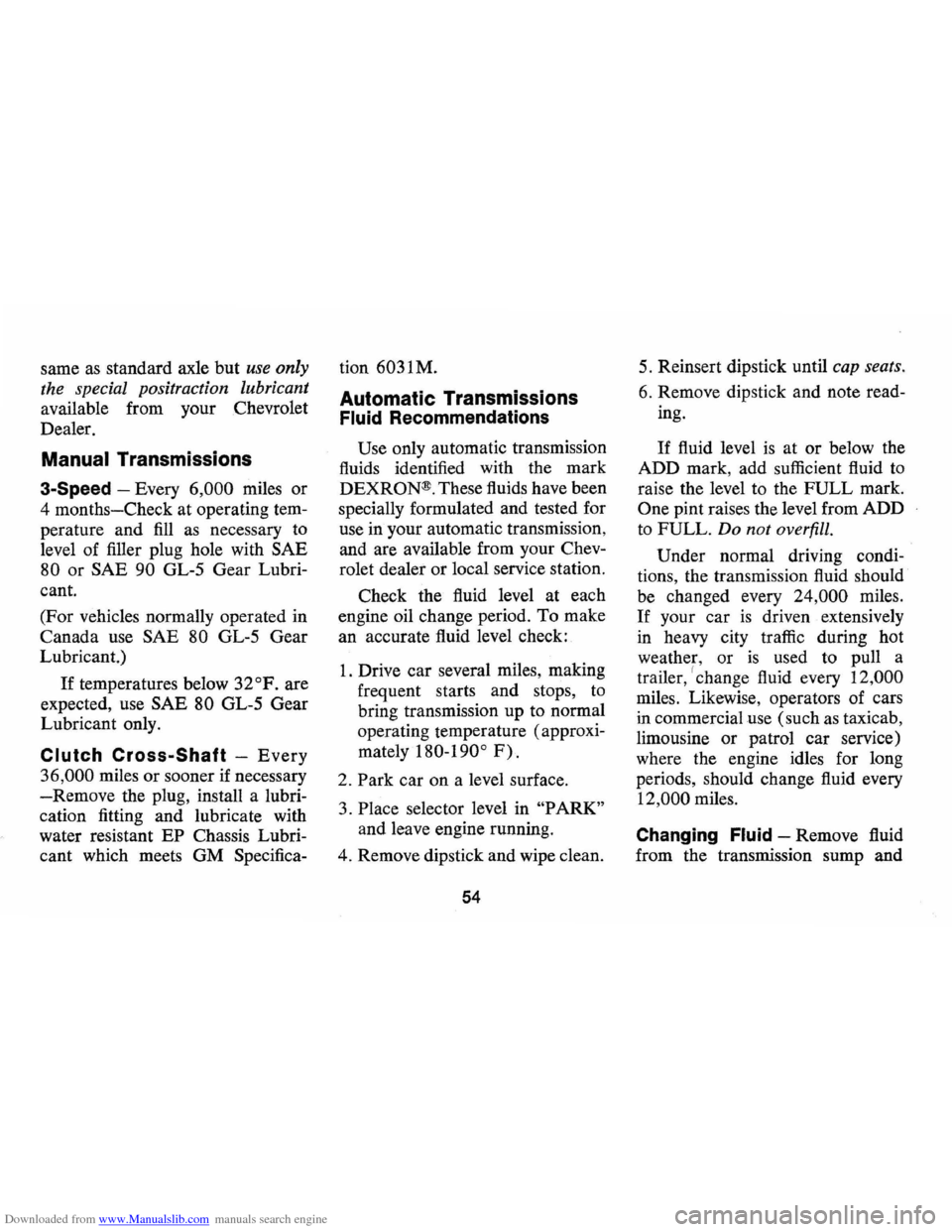
Downloaded from www.Manualslib.com manuals search engine same as standard axle but use only
the special positraction lubricant
available from your Chevrolet
Dealer.
Manual Transmissions
3-Speed -Every 6,000 miles or
4 months-Check at operating tem
perature and
fill as necessary to
level of filler plug hole with SAE
80
or SAE 90 GL-5 Gear Lubri
cant.
(For vehicles normally operated in
Canada use
SAE 80 GL-5 Gear
Lubricant.)
If temperatures below 32°F. are
expected, use
SAE 80 GL-5 Gear
Lubricant only.
Clutch Cross-Shaft -Every
36,000 miles or sooner if necessary
-Remove the plug, install a lubri
cation fitting and lubricate with
water resistant
EP Chassis Lubri
cant which meets GM Specific
a-
tion 6031M.
Automatic Transmissions
Fluid Recommendations
Use only automatic transmission
fluids identified with the mark
DEXRON ®. These fluids have been
specially formulated and tested for
use in your automatic transmission,
and are available from your Chev
rolet dealer or local service station.
Check the fluid level at each
engine oil change period. To make
an accurate fluid level check:
1. Drive car several miles, making
frequent starts and stops,
to
bring transmission up to normal
operating temperature (approxi
mately
180-190° F).
2. Park car on a level surface.
3. Place selector level in "PARK"
and leave engine running.
4. Remove dipstick and wipe clean.
54
5. Reinsert dipstick until cap seats.
6. Remove dipstick and note read
ing.
If fluid level is at or below the
ADD mark, add sufficient fluid
to
raise the level to the FULL mark.
One pint raises the level from ADD
to FULL.
Do not overfill.
Under normal driving condi
tions, the transmission fluid should
be changed every
24,000 miles.
If your car is driven extensively
in heavy city traffic during hot
weather, or
is used to pull a
trailer, {change fluid every
12,000
miles. Likewise, operators of cars
in commercial use (such
as taxicab,
limousine or patrol car service)
where the engine idles for long
periods, should change fluid every
12,000 miles.
Changing Fluid -Remove fluid
from the transmission sump and
Page 60 of 86

Downloaded from www.Manualslib.com manuals search engine and in the radiator at least as fre
quently
as engine oil changes.
NOTE: Do not remove radiator
cap when coolant
is hot and under
pressure.
Level should be at the
"FULL
COLD"
mark on the recovery tank
and at the bottom of the radiator
filler neck when the system
is cold.
During normal warm weather op
eration the coolant should be at
the
"FULL HOT" mark on the re
covery tank.
If the recovery tank is
empty or coolant is below the
"FULL COLD" mark the radiator
level should be checked and cool
ant added to the radiator and re
covery tank
as needed. Use a 50/50
mixture of high-quality ethylene gly
col antifreeze and water for coolant
additions.
If regular additions are
required see your dealer for a cool
ing system check.
NOTE: If recommended quaIily
antifreeze is used, supplemental in
hibitors or additives claiming to
provide increased capability are
not necessary. They may be detri
mental
to the efficient operation of
the system, and represent an un
necessary operating expense.
Every year, the cooling system
should be serviced
as follows:
1 . Wash radiator cap and filler
neck with clean water.
2. Check coolant for proper
level and freeze protection.
3. Pressure test system and radi
ator cap for proper pressure
holding capacity (15 psi).
If
replacement of cap is re
quired, use the special AC
cap designed for coolant re
covery systems, specified for
your car model.
4. Tighten hose clamps and in
spect all hoses. Replace hoses
58
whenever swollen, checked or
otherwise deteriorated.
5. Clean frontal area of radiator
core and air conditioning
condenser.
Every two years or
24,000 miles,
whichever first occurs, the cooling
system should be flushed and re
filled using the following recom
mended procedure:
1. Run engine, with radiator cap
removed, until normal operat
ing temperature
is reached
and upper radiator hose
is hot
(indicates thermostat
is open.)
2. Stop engine and open radiator
drain valve to drain coolant.
(To speed this operation, the
drain plugs in the block can
also be removed.)